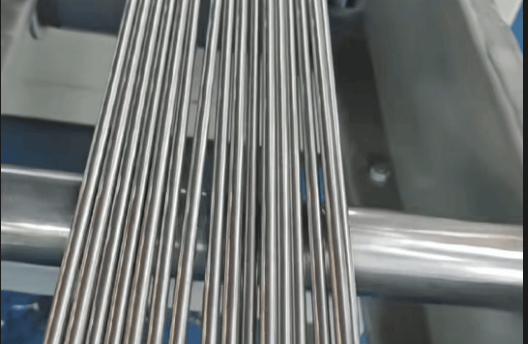Cleanroom Stainless Steel Tubing Solutions for Maximum Efficiency
Discover high-quality Cleanroom Stainless Steel Tubing Solutions, engineered for optimal cleanliness and performance in sterile environments. Ideal for semiconductors, biopharma, and beyond.
Sheentube
10/30/20243 min read


What Testing Standards Should I Look for When Buying Stainless Steel Tubing?
When selecting stainless steel tubing, particularly for precision-driven industries like biopharmaceuticals, food processing, and semiconductors, ensuring the product meets key testing standards is critical. These standards verify that the tubing can withstand various environmental factors, ensuring safety, longevity, and consistent performance in high-demand applications. Here, we explore essential testing standards and processes you should look for when buying stainless steel tubing.
1. ASTM Standards for Mechanical Properties
The American Society for Testing and Materials (ASTM) sets critical standards for assessing the mechanical properties of stainless steel tubing. ASTM A213 and ASTM A269 are two vital standards widely used in industries requiring high-performance tubing. These standards cover criteria such as tensile strength, yield strength, and elongation. For example, ASTM A213 specifies requirements for seamless ferritic and austenitic alloy-steel boiler and heat-exchanger tubes, ensuring that the tubing can withstand high temperatures without compromising its structural integrity.
Key Point: Compliance with ASTM standards guarantees that stainless steel tubing maintains mechanical reliability, even under demanding conditions.
2. ASME Compliance for High-Pressure Applications
For applications where high pressure is a significant factor, look for tubing that meets the standards set by the American Society of Mechanical Engineers (ASME), particularly ASME SA-213. This standard is critical for heat-exchanger tubes in high-pressure environments and ensures consistent material strength and dimensional accuracy.
Key Point: ASME compliance assures that the tubing can handle high-pressure conditions without risk of failure, making it suitable for critical applications in chemical processing and refineries.
3. ISO 9001 for Quality Management
ISO 9001 certification is an internationally recognized standard for quality management systems. While ISO 9001 does not directly test the tubing’s physical properties, it ensures that the manufacturing process adheres to strict quality management practices. Tubing produced under ISO 9001-certified facilities benefits from consistent quality control, traceability, and documentation, which are crucial for industries where reliability is paramount.
Key Point: ISO 9001 certification ensures that the tubing manufacturer follows strict quality control, reducing the risk of defects and enhancing product reliability.
4. SEMI F19 Standard for Ultra-Clean Manufacturing
For semiconductor and cleanroom environments, SEMI F19 is a critical standard. This standard governs the material specifications and cleanliness of stainless steel tubing used in ultra-clean manufacturing environments, where contamination must be minimized. SEMI F19 ensures that the tubing is free of particulate contamination and maintains high corrosion resistance, essential for semiconductor manufacturing.
Key Point: SEMI F19 compliance is essential for tubing used in ultra-clean environments, reducing contamination risk and ensuring optimal performance in sensitive applications.
5. Corrosion Resistance Testing: ASTM G48
Corrosion resistance is a crucial quality for stainless steel tubing in corrosive environments. ASTM G48 is a common test used to assess the pitting and crevice corrosion resistance of stainless steel tubing. This test is especially relevant for industries where the tubing will be exposed to harsh chemicals or salty environments, such as marine and chemical processing applications.
Key Point: ASTM G48 testing helps verify the tubing’s resilience against corrosion, extending its lifespan in challenging environments.
6. Surface Roughness Testing: Ra Measurements
For industries requiring high precision and cleanliness, such as pharmaceuticals and semiconductors, the surface roughness of stainless steel tubing is critical. Tubing with a roughness average (Ra) of ≤0.25 micrometers is often required to reduce bacterial adherence and contamination. Standards like ASME BPE set guidelines for acceptable surface finishes in bioprocessing equipment.
Key Point: Ensuring low surface roughness is essential for maintaining cleanliness and reducing contamination in high-purity applications.
7. Non-Destructive Testing (NDT): Ultrasonic and Eddy Current Testing
Non-destructive testing methods such as ultrasonic and eddy current testing help detect internal or surface defects in stainless steel tubing without damaging the product. Ultrasonic testing uses high-frequency sound waves to detect cracks or voids, while eddy current testing identifies surface flaws and verifies material consistency.
Key Point: NDT ensures that the tubing is free from internal and surface defects, enhancing the product’s overall reliability.
8. Hydrostatic Testing for Leak Prevention
Hydrostatic testing applies pressure to the tubing to ensure it can withstand operating conditions without leaking. This test is crucial for applications involving fluid transfer, as even minor leaks can compromise safety and efficiency.

Sheentube
High-quality stainless steel tubes for industries.
+86 15203012590
© 2024. All rights reserved.
